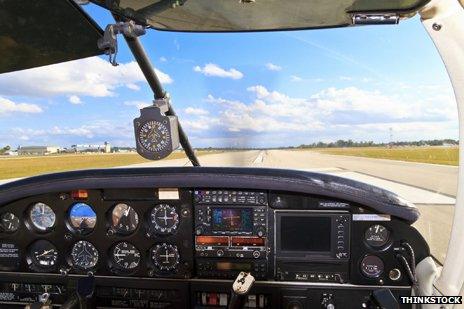Who, what, why: How hard is it to land a plane?
- Published

A passenger managed to land a plane after its pilot fell ill. How difficult is it to bring an aircraft safely down without training?
It's the stuff of disaster films - to be left on board a plane mid-flight, without anyone to fly it. A passenger after the pilot collapsed has been praised for taking over in the cockpit of a light plane flying over Lincolnshire.
The passenger was able to land at Humberside Airport on the fourth attempt, with the help of two instructors who talked through the process. The pilot later died.
"I felt for the instructors because I could put myself in their position," says Graham Stables, an instructor from North London Flying School.
Usually having some sort of rudimentary flying experience is key, suggests Stables.
Landing an aeroplane would be very hard for a complete novice, he says. Normally, a learner pilot would spend at least 20 hours before attempting to fly solo, and even then, the first time a student goes out alone is nerve-racking for the teacher.
Stables says that if he were on the ground, he wouldn't get the pilot to land immediately. "I'd want them to get familiar with the controls. Then it's a case of briefing them about what's going to happen."
A longer runway would give the pilot a better chance of a successful landing, he says. "Humberside has quite a long runway, which is important. Anything shorter than a kilometre would be difficult for a novice."
The airport would have cleared the area, and alerted the emergency services.
Stables says that as a final precaution he would instruct the pilot to use the mixture lever to shut off the plane's engine just before landing. This is to lessen the risk of fire. If a fuel line is broken on impact with the ground, the plane is less likely to ignite if the engine is empty.
Stables says that situations such as the one at Humberside Airport are so rare that they are not something for which flight instructors receive special training. However, several schools - including his own - run co-pilot courses for people who are likely to be frequent passengers in light planes. These generally consist of several hours in a dual-control aircraft being taught about the controls and executing a landing under supervision.
Aside from this, the key to a safe landing is the attitude of the person in the cockpit, and their ability to remain calm, according to former pilot Eric Moody. "I don't want to make it sound easy because it isn't. Lots of people I know would go silly, but it depends on how strong your sense of self-preservation is."
Moody knows what it's like to be up in the air and facing the unknown. In 1982 he was at the controls of a BA Boeing 747 above Indonesia, when volcanic ash caused all four of its engines to fail at once. At best, he and his passengers faced a crash-landing in the sea. He believes that his ability to stay calm got him through. "If something big happens, I slow down and think at half speed and I see beyond the immediate problem."
Moody and his pilots made a careful descent and their patience was rewarded after the engines eventually re-started. They brought the plane in to land safely in Jakarta.
Moody sees parallels with yesterday's incident. "The chap was brave to do it but he had to live. He was together enough in his mind to cope - not everyone would have done that."
He says that although modern planes are to a great extent flown by computer, he doubts whether air flight can completely eliminate the element of skill and judgement which a good pilot brings to bear. It's a test that he thinks yesterday's passenger-turned-pilot passed: "It doesn't matter how you land it as long as you walk away from it."
Reporting by Ben Milne.
You can follow the Magazine on and on